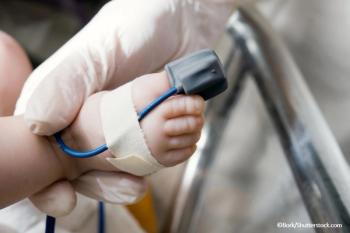
Portal Vein Thrombosis
A 60-year-old man presented to the emergency department (ED) with fever of 1 day’s duration and midabdominal pain. The cramping pain had begun 3 days earlier in a bandlike distribution around the upper abdomen. Ingestion of food exacerbated the discomfort. The patient had a history of intermittent constipation; he denied alcohol or illicit drug use, nausea, vomiting, and weight loss. He did not use any herbal or over-the-counter medications.
A 60-year-old man presented to the emergency department (ED) with fever of 1 day’s duration and midabdominal pain. The cramping pain had begun 3 days earlier in a bandlike distribution around the upper abdomen. Ingestion of food exacerbated the discomfort. The patient had a history of intermittent constipation; he denied alcohol or illicit drug use, nausea, vomiting, and weight loss. He did not use any herbal or over-the-counter medications. His father had a history of deep vein thrombosis. Ten years earlier, a total gastrectomy with splenectomy had been performed for a spindle cell sarcoma of the stomach that adhered to the spleen. The hospital course had been complicated by a subdiaphragmatic abscess, which was treated with multiple drainage procedures and antibiotics. Radiologic studies confirmed that the abscess had resolved. In the ED, the patient’s temperature was 38.2oC (100.7oF). There was no lymphadenopathy or icterus. His abdomen was soft; the epigastrium was tender to deep palpation. There was no ascites. Midline and left subcostal scars were noted. Heart and lung examinations were normal. Stigmata of liver disease were absent. Extremities were normal. A stool hemoccult test was negative. The white blood cell count was 13,100/μL; hemoglobin, 10.7 g/dL; and platelet count, 553,000/μL. Coagulation parameters were normal. Liver and renal function test results were normal. Amylase was 82 U/L; lipase was 15 U/L. Hepatitis profile results were negative. The CT scan with contrast (A) showed abnormal low density in the main portal vein, right and left portal veins, and superior mesenteric veins; this finding suggested acute/subacute thrombosis. A color duplex scan (B) confirmed the findings. Further investigations revealed normal factor V Leiden and plasma homocysteine levels. A negative sugar water test ruled out paroxysmal nocturnal hemoglobinuria. Tests for lupus and the lupus anticoagulant were negative. The patient had a normal protein S level; however, the protein C activity was 70% (normal, 72% to 140%). Drs Manisha Balwani, Asif Merchant, Parthas Narashimhan, and Hamida Merchant of Forest Hills, NY, comment that acute portal vein thrombosis is usually a clinically silent event. Often, it is detected as an incidental finding during radiologic examination. In most patients, the thrombosis reflects either an alteration in coagulation or stasis of portal venous flow that is caused by an underlying process. Many of these patients have underlying hypercoagulable states. In this patient, the cause of the thrombosis was unclear. The borderline low protein C level can imply either a thrombophilic genotype, such as protein C deficiency, or an acute thrombotic event. Previous intraabdominal surgery, possible retroperitoneal fibrosis, and postsplenectomy thrombocytosis can contribute to thrombosis. Portal vein thrombosis can be treated with long-term anticoagulation. Some studies have reported recanalization of the portal vein when anticoagulation was begun at the time of diagnosis and continued for at least 4 months.1 Anecdotal reports have documented the successful use of thrombolytic agents for lysis of portal vein thrombosis, although the benefit of this approach is uncertain.2 This patient was given intravenous heparin, then oral warfarin.The symptoms gradually abated, and he was discharged from the hospital with a prescription for oral warfarin. Five months later, a CT scan of the abdomen demonstrated a nearly resolved portal vein thrombus with prominent enhancing collateral vessels (C).
Newsletter
Enhance your clinical practice with the Patient Care newsletter, offering the latest evidence-based guidelines, diagnostic insights, and treatment strategies for primary care physicians.




















































































































































































































































































